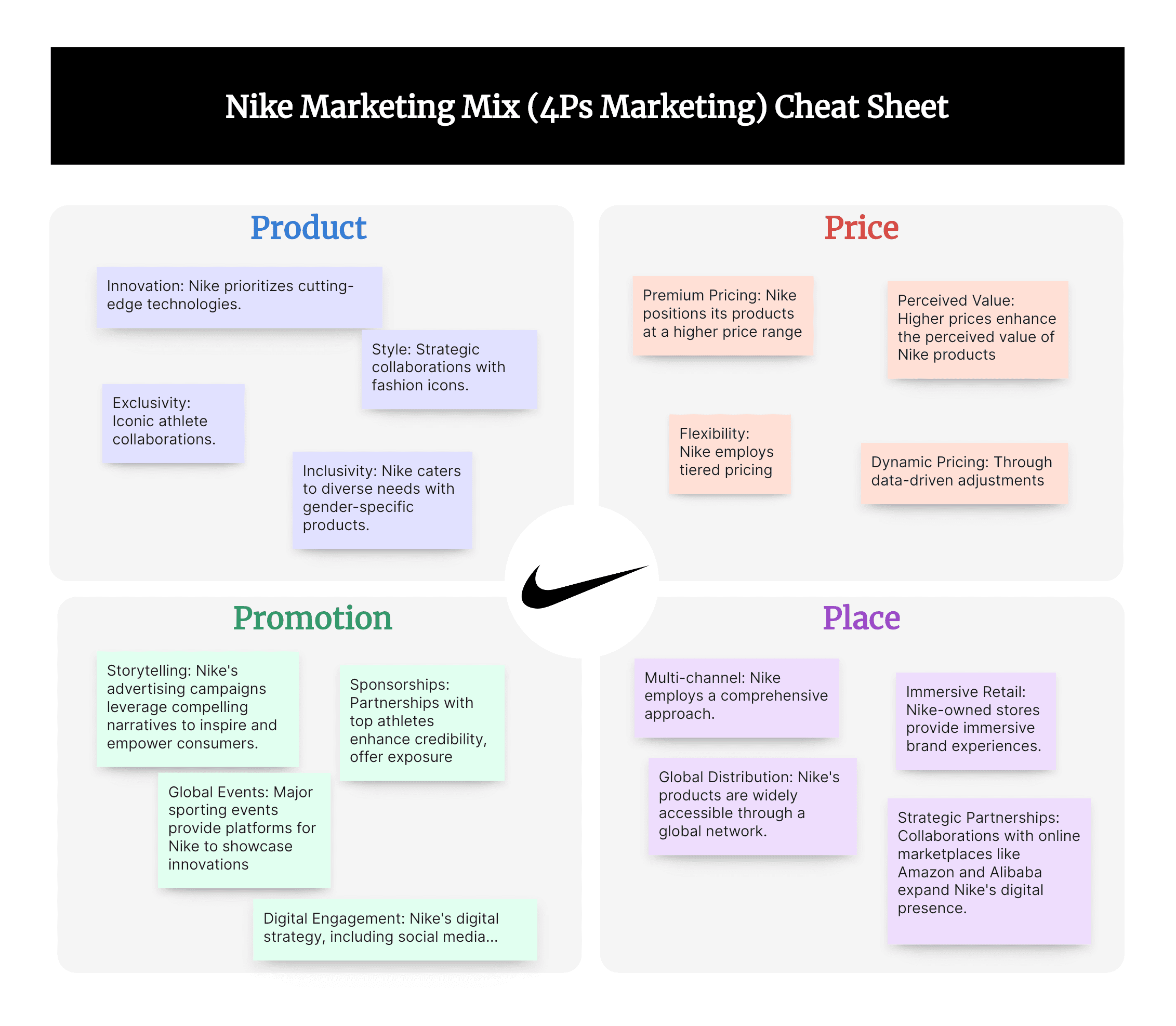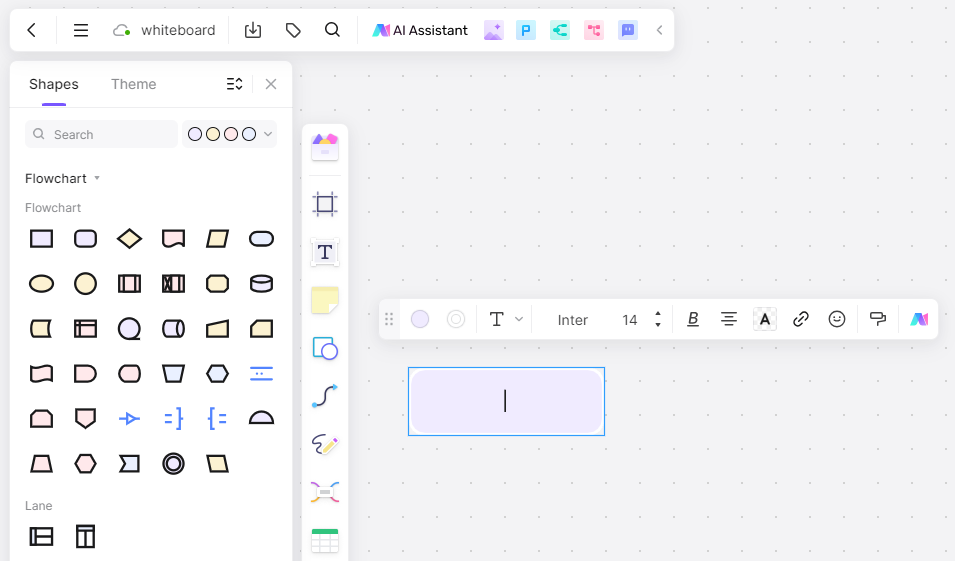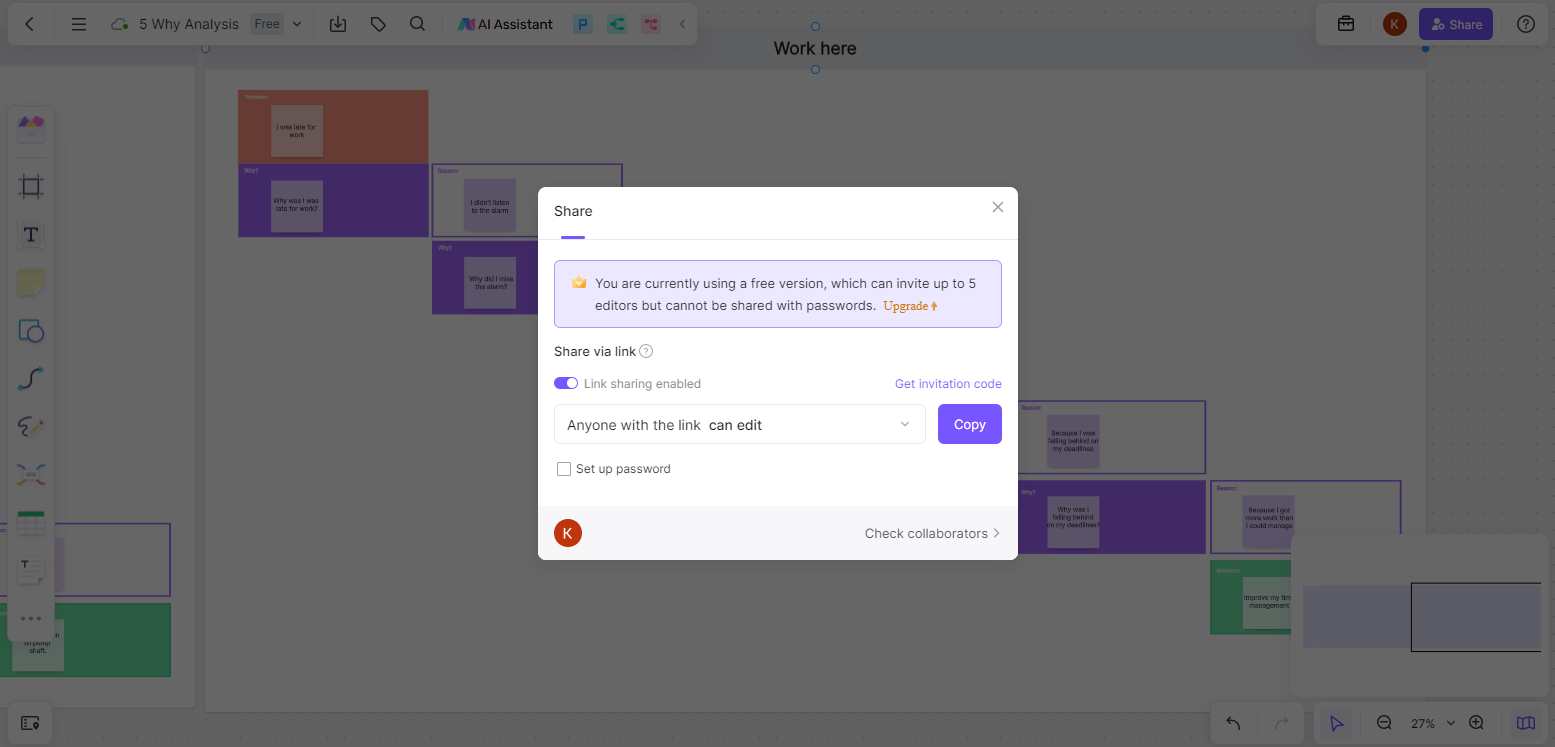In the world of sportswear and athletic footwear, few brands command as much respect and recognition as Nike. The brand's extraordinary growth and success aren't accidental, but rather the result of a well-thought-out and meticulously executed marketing mix strategy, often referred to as the 4Ps - Product, Price, Place, and Promotion. In this comprehensive analysis, we dissect Nike's marketing mix and reveal the secret ingredients behind its market domination.
Nike Marketing Mix (4Ps) Mind Map
When exploring the expansive marketing mix of Nike, it's beneficial to visualize the interplay of its 4Ps. Below is a mind map providing a bird's-eye view of Nike's marketing strategy. Each P—Product, Price, Place, and Promotion—represents a key pillar of this strategy and allows Nike to appeal to its target audience effectively.

Product Strategy of Nike
Nike's product strategy forms the bedrock of its overarching marketing mix strategy. It is distinguished by an extensive portfolio that covers athletic shoes, apparel, equipment, and accessories catering to a wide array of sports.
The defining hallmark of Nike's product strategy is its unwavering commitment to innovation. Recognizing the competitive nature of the sportswear market, Nike consistently invests in research and development to churn out products featuring cutting-edge technologies. Examples include its patented Flyknit technology, which ensures superior comfort and fit in footwear, and React foam which guarantees unrivaled cushioning and energy return.
Nike is not just about functionality; style forms a significant component of its product strategy. Through strategic collaborations with high-profile designers and fashion brands like Off-White and Sacai, Nike has elevated sportswear to high-fashion levels. The company leverages these partnerships to infuse trendiness into its products, thus striking a balance between performance and aesthetics that appeals to athletes and fashion enthusiasts alike.
In addition, Nike masterfully utilizes its product strategy to create exclusivity around its brand. The brand's numerous collaborations with high-profile athletes such as Michael Jordan, Lebron James, and Serena Williams have given birth to iconic lines like Air Jordan, Lebron, and the Serena Williams Collection. These signature lines further elevate Nike's status in the market, infusing a level of desirability and exclusivity that few competitors can match.
Importantly, Nike adopts an inclusive approach in its product strategy, recognizing the varied needs and preferences of its diverse customer base. From gender-specific products to inclusive sizing and adaptive footwear for people with disabilities, Nike endeavors to cater to everyone. This approach not only widens its customer base but also fosters a deeper connection with consumers.
Nike's product strategy is characterized by a relentless pursuit of innovation, a keen eye for style, collaborations with big names, exclusivity, and inclusivity. This dynamic interplay of factors keeps the brand at the forefront of the sportswear market and cements its place as a beloved brand among consumers worldwide.
Price Strategy of Nike
The price strategy of Nike is intricately tied to the brand image it has cultivated over the years. Adopting a premium pricing strategy, Nike’s products are often positioned at the higher end of the pricing spectrum. However, far from deterring customers, this pricing strategy has proven to be a key driver in the company's overall success and has significantly contributed to its esteemed status in the global market.
A notable aspect of Nike's price strategy is that it complements its product strategy. The innovative technology, stylish design, and premium quality that define Nike's offerings naturally warrant a higher price tag. Thus, the high prices reflect and reinforce the superior quality and value that Nike products deliver. In other words, the premium pricing serves to enhance the perceived value of its products.
Nike’s premium pricing helps cement its image as a high-end, aspirational brand. The higher prices contribute to creating an aura of exclusivity around Nike products. Customers are not just purchasing a product; they are buying into a lifestyle, an image of success and aspiration that Nike embodies. This perceived prestige associated with owning a Nike product further incentivizes customers to purchase despite the higher prices.
However, Nike's pricing strategy isn't rigid; it displays a degree of flexibility that allows it to cater to various market segments. For instance, while its latest and most technologically advanced products command premium prices, Nike also offers products at lower price points to cater to cost-conscious customers. This tiered pricing strategy allows it to maximize its market reach and maintain its wide customer base.
Moreover, Nike employs dynamic pricing on its digital platforms. Using consumer data and advanced algorithms, Nike adjusts the prices of its products based on demand, consumer behavior, and market conditions, ensuring optimum profitability.
Nike's price strategy is a carefully orchestrated mix of premium pricing, flexibility, and dynamic online pricing. The premium pricing aligns with its high-quality offerings and exclusive brand image, while its flexibility ensures a broader market reach. The strategic use of dynamic pricing on its digital platforms helps optimize profits, marking another win for Nike's robust pricing strategy.
Place Strategy of Nike
The place strategy, or distribution strategy, is a critical element of Nike’s marketing mix. Ensuring its products are available where and when customers want them is a fundamental goal of the company, which it achieves through a comprehensive multi-channel approach.
Firstly, Nike products are distributed through a global network of Nike-owned retail stores, which includes Nike Towns and Factory stores. These stores, often located in strategic high-traffic areas or premium shopping districts, serve as much more than mere points of sale. They embody the brand ethos, providing customers with immersive brand experiences. They showcase the breadth and depth of Nike's product range, display the latest innovations, and offer personalized services like custom design options for selected footwear.
Online, Nike’s robust e-commerce platform is another primary sales channel. With intuitive navigation, detailed product descriptions, and user reviews, the site mimics the in-store experience but offers customers the convenience of shopping from home. Furthermore, Nike's mobile apps like SNKRS for sneaker releases and the Nike app for general shopping provide seamless mobile shopping experiences.
In addition to its owned retail and online channels, Nike distributes its products through a variety of third-party retailers. These include large department stores, sporting goods retailers, and specialty athletics shops. This extensive network of wholesale partners helps broaden Nike's reach and ensures that their products are widely accessible.
Moreover, with the understanding that different market segments have varying needs and preferences, Nike employs a differentiated market coverage strategy. It targets different markets with different distribution strategies. For instance, in established markets like the United States and Europe, Nike focuses on direct-to-consumer channels to build deeper connections with consumers. In contrast, in emerging markets, it often leverage third-party partnerships to penetrate new territories effectively.
A recent notable expansion of Nike's place strategy is its strategic partnerships with online marketplaces like Amazon and Alibaba. Recognizing the shift towards online shopping and the immense customer base these platforms possess, these partnerships further amplify Nike's digital presence and extend its global reach.
Promotional Strategy of Nike
Nike's promotional strategy is renowned for being innovative, emotional, and impactful. This multifaceted approach aims to enhance brand visibility, create brand resonance, drive sales, and ultimately establish an emotional connection with consumers that goes beyond the products.
A key facet of Nike's promotional strategy is its masterful use of storytelling in its advertising campaigns. The brand's advertisements often revolve around compelling narratives that inspire and empower. Be it the celebration of athletes' triumphs, the championing of underdogs, or the challenge to societal norms, Nike ads tell stories that resonate with audiences on a deeply emotional level. Their "Just Do It" campaign is one such instance that has been successful in captivating audiences and instilling motivation and self-belief.
Sponsorships and collaborations form another significant component of Nike's promotional strategy. The company has been associated with some of the biggest names in sports, including Michael Jordan, Serena Williams, and Cristiano Ronaldo. These partnerships serve multiple purposes – they enhance Nike's credibility as a high-performance sportswear provider, they offer invaluable exposure through the athletes' extensive fan bases, and they lead to popular product lines like Air Jordans and Mercurial Superfly.
Further, Nike capitalizes on major global sporting events like the Olympics or the FIFA World Cup for promotional purposes. Such events are an opportunity for Nike to showcase its latest innovations and cement its presence in the world of sports.
In the digital realm, Nike's promotional strategy shines just as bright. The company leverages social media platforms to engage with its audience through inspiring content, interactive challenges, product teasers, and much more. Moreover, Nike effectively uses email marketing to send personalized product recommendations and promotional offers to its customers.
Nike also adopts experiential marketing strategies to enhance customer engagement. It hosts events like the annual Air Max Day and organizes activities like running clubs and training sessions. These initiatives allow customers to engage with the brand on a personal level and foster a sense of community among users.
Finally, a key element of Nike's promotional strategy is Corporate Social Responsibility (CSR). Through initiatives that promote equality, environmental sustainability, and community development, Nike reinforces its commitment to making a positive impact on society.
Nike Marketing Mix (4Ps) Cheat Sheet
To condense the comprehensive analysis into an easy-to-grasp format, here’s a simplified cheat sheet of Nike’s marketing mix strategy. This quick reference guide summarizes the critical points about each P in Nike’s strategy and can be a valuable resource for marketers and business professionals.

Key Takeaways
Nike's marketing mix strategy exhibits deep insights into its target audience and the market at large. Its balanced combination of innovative products, premium pricing, strategic placement, and emotionally resonant promotions forms a masterclass in modern marketing.
For marketers looking to emulate such success, we recommend using Boardmix's pre-built 4Ps of Marketing Template. This tool provides an accessible framework for strategizing your marketing mix and equips you with essential tools for market success. After all, a good marketing mix strategy could mean the difference between a brand that barely stays afloat and one that, like Nike, becomes a global giant.
Steps to Use 4P's Template on Boardmix
To use this 4P'sTemplate, you can navigate to the workspace of Boardmix, an online whiteboard that provides various free templates. This step-by-step guide will help you use the 4P's template effectively to streamline your drawing process.
Step 1: Log in to Your Boardmix Account
To get started, log into your Boardmix account using your credentials. If you're new to Boardmix, create an account by following their easy sign-up process.

Step 2: Search and Choose 4P's Template
Once you've logged in, navigate to the 'Templates' section available on the platform's main page. Here, you'll find a plethora of ready-to-use templates categorized under various topics, use the search bar for a quicker find.

Step 3: Customize and Edit Your 4P's Template
After selecting the template, it will open in a new Boardmix workspace. Boardmix gives you complete freedom to customize it as per your unique needs. You can:
- Add or delete sections: Click on an existing section and hit the 'Delete' button on your keyboard to remove it. To add new sections or fields, select the 'Text' option from the toolbar and click on the board where you wish to add content.
- Modify text: To edit any text, click on it to open the text box and make your changes.
- Change visual elements: Boardmix allows you to modify colors, fonts, or border styles. These visual elements can be tailored to match your own needs.

Step 4: Save Your Work, Share and Collaborate
Boardmix will save your work online anytime. Once you have customized the template to your satisfaction, you can then share it with other members for collaboration.

Boardmix's collaboration feature allows multiple people to view and edit the feedback form simultaneously in real time. All data is stored safely on Boardmix, making it a reliable tool for maintaining records over time. Get started and try it for free now!








